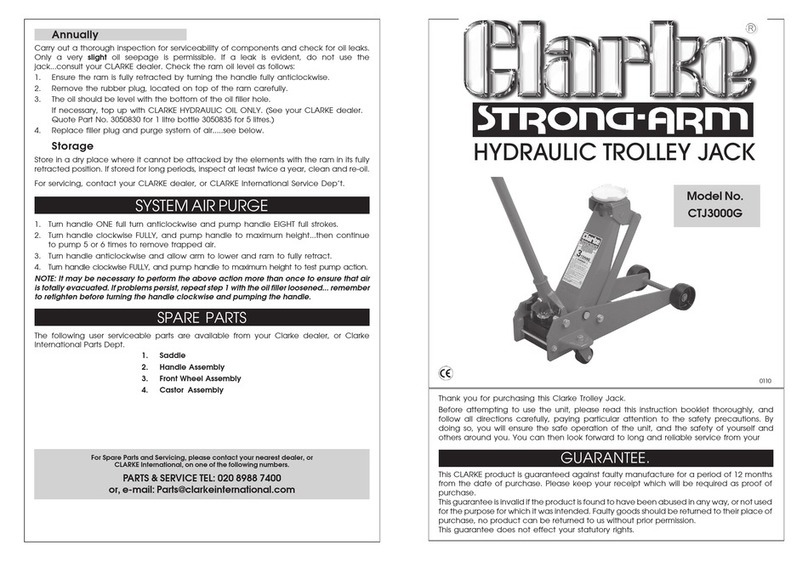sollevamento del carico. Sollevare tramite il manico fino a raggiungere l'altezza desiderata. Dopo
il sollevamento, fissare e trasferire il carico su cavalletti o altri mezzi appropriati. Non utilizzare
MAI il sollevatore come unico mezzo di supporto.
5.Chiudere la valvola di sfiato ruotando la leva in senso orario fino a quando la valvola non è ben
chiusa.
6.Prima di sollevare il veicolo ricontrollare e verificare che il piattello sia centrato e che sia anche a
pieno contatto con il punto di sollevamento.
7.Muovere la leva in su e in giù per sollevare finché il piattello non tocca il carico. Continuare
sollevare il veicolo all'altezza desiderata. Dopo il sollevamento, supportare il carico su opportuni
cavalletti di sostegno.
ABBASSAMENTO
1.Sollevare il carico abbastanza in alto da consentire la rimozione dei cavalletti di sostegno.
2.Rimuovere i cavalletti di sostegno.
3.Afferrare saldamente la maniglia del sollevatore.
4.Aprire con cautela la valvola di rilascio ruotando lentamente la maniglia in senso antiorario.
(assicurarci che non ci sia nessuno vicino al carico).
5.Una volta rimosso il carico dal sollevatore, posizionare il sollevatore completamente abbassato
in modo tale da evitare l’esposizione alla polvere/detriti e alla ruggine.
NOTA: riporre sempre il sollevatore in posizione completamente abbassata e la maniglia in
posizione verticale.
Quando il sollevatore non è in uso riporlo con il braccio di sollevamento completamente abbassato.
Tenerlo sempre in buono stato, pulito e lontano dalla portata dei bambini.
Per verificare il livello dell’olio, aprire la valvola di rilascio ruotando in senso antiorario la leva di
azionamento (A) e, abbassare al minimo il piattello reggi carico. Rimuovere il tappo dell’olio.
Assicurarsi di non introdurre polvere e corpi estranei insieme al nuovo olio. Se il livello dell’olio è
basso, il sollevatore non riuscirà a raggiungere la massima altezza. NON utilizzare MAI olio per
freni, per turbine, per cambi o motore. L’utilizzo di olio inappropriato può danneggiare il sollevatore
portando alla perdita della portata massima di carico. Utilizzare esclusivamente olio per sollevatori
idraulici (ISO 32). Rimettere il tappo dell’olio.
Lubrificare i componenti del sollevatore quando necessario per evitare la formazione di ruggine e
usura.
Quando l’utensile non è più utilizzabile né tanto meno riparabile, smaltirlo secondo le norme
vigenti del luogo al fine di salvaguardare l’ambiente.



























